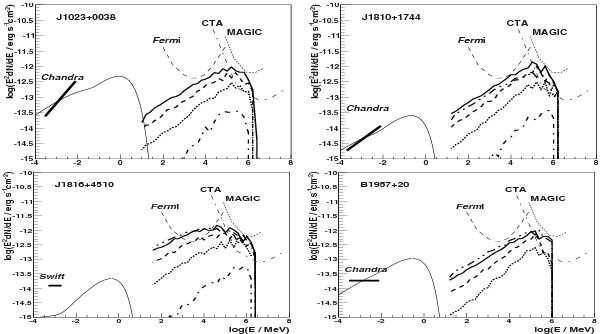Fig. 3

Comparison of the high-energy emission (energy flux versus energy) expected from the MSP binary systems with the sensitivities of Fermi-LAT (10 yrs – extragalactic background, see thin dashed curve, Funk et al. 2013), MAGIC (thin dotted curve, Aleksić et al. 2012) and CTA (thin dot-dashed, Bernlohr et al. 2012), for different ranges of observation angles: 0.9 ≤ cosβ ≤ 1.0 (dot-dashed, away from the companion star), 0.5 ≤ cosβ ≤ 0.6 (dotted), − 0.1 ≤ cosβ ≤ 0. (dashed), − 0.5 ≤ cosβ ≤ − 0.4 (solid), − 1.0 ≤ cosβ ≤ − 0.9 (dot-dot-dashed). The other parameters of the models have been fixed on σ = 10-4, and vadv = 1010 cm s-1, and Ee is given by Eq. (7). The spectra are normalized to the X-ray fluxes observed from PSR B1957+20 (Huang et al. 2012), PSR J1023+0038 (Bogdanov et al. 2011), PSR J1810+1744 (Gentile et al. 2013). For PSR J1816+4510, the upper limit derived from the Swift data (Kaplan et al. 2012). The spectra have been calculated for the energy conversion efficiencies from pulsars to relativistic electrons estimated on 1.6 × 10-2 (for PSR J1023+0038), 6.5 × 10-2 (PSR J1810+1744), 5 × 10-3 (PSR J1816+4510), and 1.8 × 10-3 (PSR B1957+20).
Current usage metrics show cumulative count of Article Views (full-text article views including HTML views, PDF and ePub downloads, according to the available data) and Abstracts Views on Vision4Press platform.
Data correspond to usage on the plateform after 2015. The current usage metrics is available 48-96 hours after online publication and is updated daily on week days.
Initial download of the metrics may take a while.






